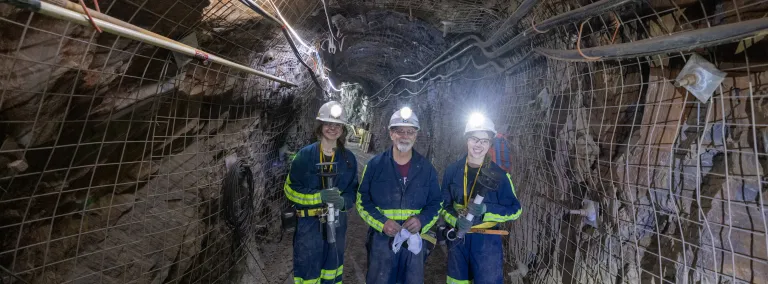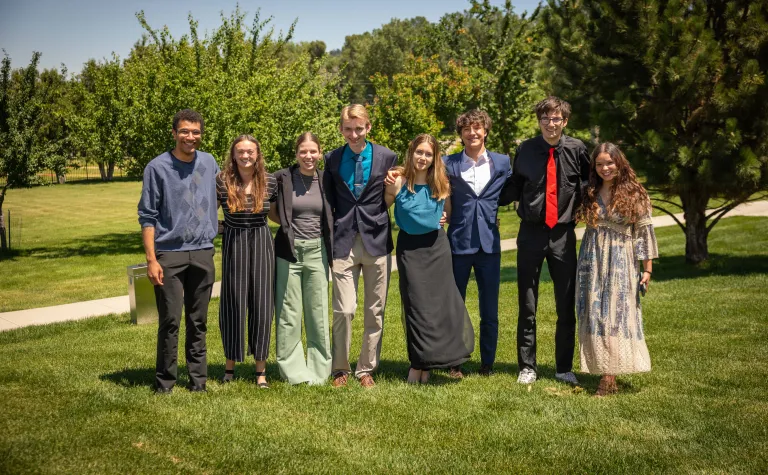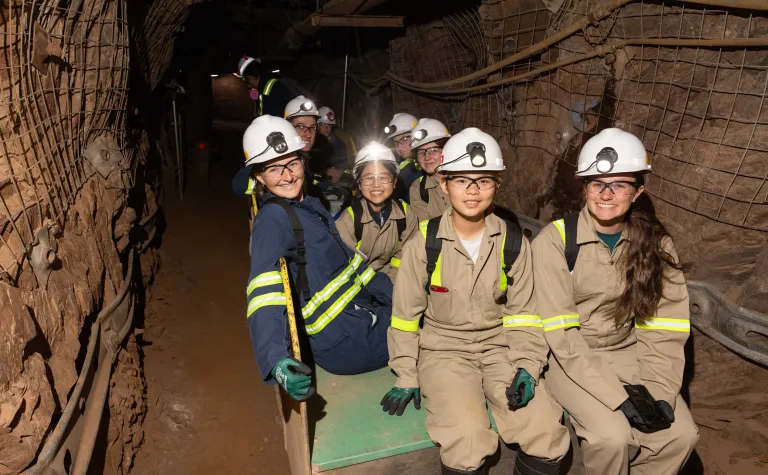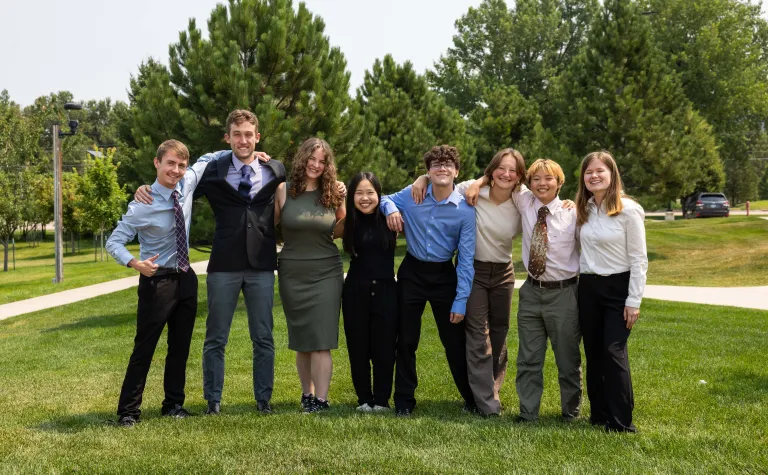High school students provide valuable airflow data to America’s Underground Lab
Since 2012, Spearfish High School science teacher Steve Gabriel has been leading a student mentorship program that gives his students hands-on, real-world experience in monitoring the underground airflow at SURF.
There is a general rule for underground spaces: the deeper you go, the hotter it gets.
The walls of rock 4850 feet below the surface inside the Sanford Underground Research Facility (SURF) have an ambient temperature above 90 degrees. To offset what would otherwise be impossible working conditions inside the laboratory spaces at SURF, a team of engineers and technicians manages airflow underground. Air from the surface is drawn down the Yates and Ross Shafts and pulled back out through the large fans of the Oro Hondo and #5 Shafts.
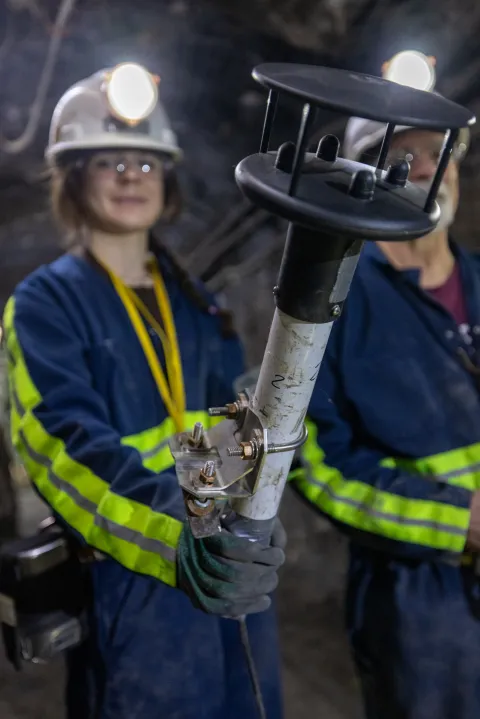
Charlie Nickles, a senior at Spearfish High School, holds one of the modified underground weather stations that monitors air flow at SURF.
Photo by Matthew Kapust.
Ventilation for underground spaces is a specialty subject inside the field of mining engineering. Mine ventilation can take years of study and college-level courses in subjects like fluid dynamics to master. For the past 13 years, local high school student interns have helped gather vital data used to manage air flowing through America’s Underground Lab.
The student interns deploy, maintain, and monitor real-time data from a series of underground weather stations that track airflow, temperature, pressure and humidity.
The project at SURF was started in 2012 by Stephen Gabriel, who has taught physics and physical sciences at Spearfish High School for the past 33 years. Read more about the work of Mr. Gabriel and his students in this 2022 article by Erin Lorraine Woodward.
Charlie Nickles, a senior at Spearfish High School, is in her second year of the internship under Gabriel. This spring, she took her first trip underground to inspect and replace some of the weather stations she has been monitoring during her time as a student.
“When we went underground for the first time, it was unexpected, being there, and meeting all the people who work there, and getting to see what the flow meters do. We got to see the purpose of it all, and it gave us a reason for what we're working on,” Nickles said.
The rather robust set of weather monitoring stations these students are working on includes machines they have modified and programmed to function in the underground network at SURF. Like all machines, these weather stations occasionally break down.
Fixing whatever breaks
This is where student interns like Owen Schnabel come in. As senior at Spearfish High School, he has spent many hours repairing weather stations. “We take broken ones that have been brought up after been damaged from being in the underground too long,” Schnabel said. “Sometimes they are full of dust, and that can be corrosive. So, I've been doing a lot of taking them apart, cleaning, and then trying to get them to work again, so we can, reconnect them and put them back underground.”
This kind of hands-on troubleshooting, which involves figuring out what broke and then figuring out how to fix it, is an extremely valuable skill across multiple disciplines. EllaMia Marty, another senior at Spearfish High School, has employed the electrical wiring techniques she has picked up while working on weather monitoring machines and applied them to other projects.
“I just think it's interesting seeing how we've all kind of grown in our understanding of what we're doing here,” Marty said. “Mr. Gabriel is a huge champion. If you want to do independent research, then go ahead and do it. And he fully supports and backs you.”
Enabling data-driven decisions
When Spearfish High School senior Hollie Wise was tasked to find a way to visualize the data collected by the underground stations, she began the work of translating the complex programming language of R, employed by the weather stations, into something more workable.
“For the past few months, I have been building a data visualization program in Python,” Wise said. “Essentially, it allows you to compare data from different years, different locations, and then different data types and plot the different values. This could include pressure, humidity, or temperature. It will also show you spikes like, if they're doing a blast underground, maybe you'll see pressure or temperature change because of that. So, you can kind of tell different things they're doing underground, just based on the data that's being collected and plotted.”
Being able to know what is happening underground based on the data is a very valuable tool, not only for the students, but for engineers and technicians at SURF.
One of them is Bryce Pietzyk, a trained mining engineer, who serves as the director of underground operations at SURF. Pietzyk marvels at the accomplishments of Mr. Gabriel and his students, in part because his own children were inspired when they took Gabriel’s science classes, but also because of the work he has completed at SURF.
“He took basic weather stations, did his own programming, working with the students—and built this incredible underground system tied to this hands-on curriculum. I can’t imagine how many hours he has donated to this project over his career. But it’s made a real impact on his students and SURF,” said Pietzyk.
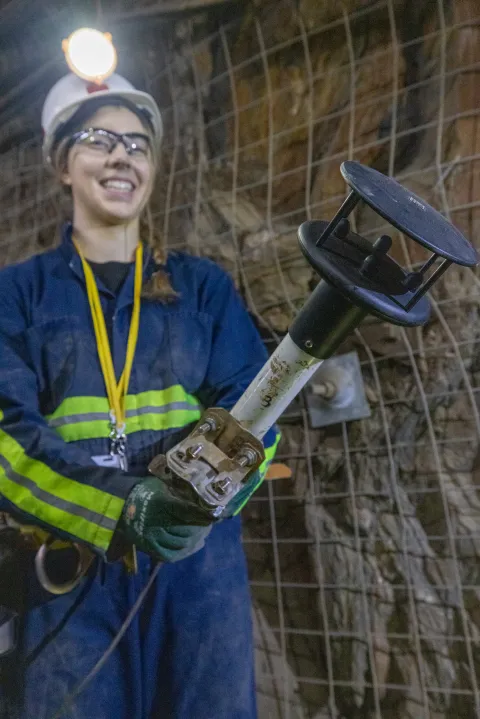
Spearfish High School senior Hollie Wise, holds one of the modified underground weather stations that monitors air flow at SURF.
Photo by Matthew Kapust
The real impact on students is measured in their incredible success. Wise, who is building the computer code needed to visualize airflow data at SURF, will graduate from high school in May after spending two years in the internship. Like many of her fellow students, she has been inspired to pursue a career in STEM—and she credits the internship for helping her land a prestigious pre-college program at the California Institute of Technology.
“I got into a program called Caltech Up Close a while ago,” Wise said. “I feel like the main reason that I got into that was because I'm participating in actual scientific research. So, I think that's one thing that I know that it's opened a lot of doors for me in that way. And it highlights and furthers my passion just to pursue a career in STEM.”
SURF’s mission is to advance world-class science and inspire learning across generations. This mission would be impossible to achieve without the incredible dedication of educators like Steve Gabriel—his work, and that of many others, has the potential to keep America’s Underground Lab supplied with the best and brightest minds in the decades to come.
